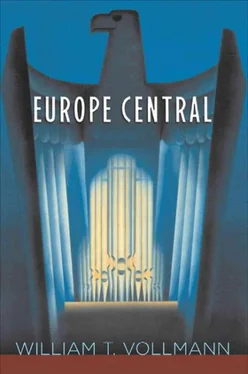580 Same footnote: Comrade Leonhard on Ulbricht: “Being entirely innocent of theoretical ideas or personal feelings…”—Wolfgang Leonhard, Child of the Revolution, trans. C. M. Woodhouse (Whitstable, Kent, U.K.: Ink Links, 1979, repr. of orig. 1957 English ed.; orig. German ed. 1950), p. 288.
580 Same footnote: A. A. Grechko on Ulbricht: “The old one isn’t worth much anymore” —Edward N. Peterson, The Secret Police and the Revolution: The Fall of the German Democratic Republic (Westport, Connecticut: Praeger, 2002), p. 5.
580 Benjamin: “Not creation of the new, but restoration of the old”—Benjamin Stasi file, p. BStU 000010, p. 4.
581 Ulbricht: “This meeting has nothing to do with dismantling”—Leonhard, p. 343. This source also describes the confrontation with Ulbricht regarding abortion; I have reworded his answer somewhat in the imagined conversation farther on in the text, and entirely invented Benjamin’s role.
581 A few descriptions of East German landscapes, and several concepts relating to “socialist legality,” are indebted to Arthur W. McCardle and A. Bruce Boenau, eds., East Germany: A New Germany Nation Under Socialism? (New York: University Press of America, 1984), pp. 52-79 (Horst Krüger, “Alien Homeland: Sentimental Journey Through the GDR-Province,” 1978); and pp. 156-71 (Institut für Theorie des Staates und des Rechts der Akademie der Wissenschaft der DDR, “The Nature of Socialist Legality,” 1975). Krüger concludes (p. 73): “Actually the worst thing across the border was this good behavior which bores you to death.”
582 Some of the events and statistics I cite from here on are from Gary Bruce, Resistance with the People: Repression and Resistance in Eastern Germany, 1945-1955 (Oxford: Row-man & Littlefield Publishers, Inc., Harvard Cold War Studies Book Series, 2003). I am also indebted to Angela E. Stent, “Soviet Policy Toward the German Democratic Republic,” in Sarah Meiklejohn Terry, ed., Soviet Policy in Eastern Europe (New Haven, Connecticut: Yale University Press: A Council on Foreign Relations Book, 1984), pp. 34-41, 47ff.
582 Benjamin: “Law must correspond with the progression of civilization”—Steding (Gotthold Bley, “The Creative Work of Hilde Benjamin in the Formation of the GDR’s Legislation and Legal System”); Hau-Bigelow, p. 12 (abr. and reworded).
582 Most of the various East German trials and sentences are from information in Evans’s Rituals of Retribution, as are a few brief quotations from Hilde Benjamin. From this book I have borrowed, then altered and embellished, various legal phrases and pronouncements to suit the purposes of my American gangsterism. It may be of interest to the reader, as it was to me, to learn that the East German legal system was far, far less lethal than both the Nazi and the Soviet variants. Evans concludes (pp. 864-66) that the GDR executed more than two hundred people, mostly in the fifties. Soviet military tribunals in the GDR executed others. Executions for murder were abolished in 1975; capital punishment was ended entirely a few years later. Evans goes on to call Hilde Benjamin “perfectly capable of mass murder” (p. 869).
582 Sentence of six years for selling eggs in West Berlin—Bruce, p. 227.
584 Benjamin: “Thorough cleansing of the entire public sphere”—Benjamin (Pielhoop), p. 4.
584 “Her legend”: “She showed the ability to continually evolve…”—Steding (Sorgenicht); Hau-Bigelow, p. 8 (abridged and reworded; she actually proposed, still more radically, that “a law at the time of its enactment would correspond with the progression of civilization”).
584 The Red Guillotine: “Since man develops his personality primarily in work…” — GDR: 300 Questions … , p. 62.
585 Benjamin: “The important thing is to apply the laws in a new democratic spirit” —Benjamin (Pielhoop), p. 6.
585 Seventy-eight thousand charged with political crimes in 1950— Binsichten: Diktatur und Widerstand, loc. cit., p. 71. “There were no longer any classes or sections which can live at the expense of others”— GDR: 300 Questions … , p. 42 (tense altered).
585 “The legend”: “She proved capable of disciplining enemies of the new republic with unrelenting severity”—Steding (Sorgenicht); Hau-Bigelow, p. 9 (abridged and reworded).
586 West German journalist: “Who has ever once experienced this woman…” —Benjamin Stasi file, p. BStU 00051 (Die Welt, 15.8.52, Wolfgang Weinert, “Ob schuldig oder nicht schuldig”).
587 Information on the 1953 uprising—Peterson, p. 3.
587 “The General Prosecuting Authority, headed by the prosecutor general of the GDR…” — Great Soviet Encyclopedia, vol. 6, p. 315 (entry on the German Democratic Republic).
588 “The legend”: “Her most important trials are known, and need not be mentioned further.” —Steding (Sorgenicht); Hau-Bigelow, p. 9.
588 Stasi evaluation: “Comrade BENJAMIN is from the professional and political standpoint…”—Benjamin Stasi file, p. BStU 00055.
589 Comrade Gotthold Bley: “Socialist law and socialist legislation were tools, motors and levers she used”—Steding (Bley); Hau-Bigelow, p. 12.
589 Comrade Büttner: “She solidified the dialectical interrelation between law and society…”—Steding (Horst Büttner, “Keeping the Revolutionary Achievements and Experiences of Coming Generations Alive”); Hau-Bigelow, p. 18. (The original, which does refer specifically to her work as Justice Minister in those years, runs: “She solidified the inseparable connection and dialectical interrelation between law and society…”)
589 Purpose of GDR justice: “Smash the resistance of expropriated monopolists for all time…”—Somewhat after Hans Werner Schwarze, The GDR Today: Life in the “Other Germany ,” trans. John M. Mitchell (London: Oswald Wolff, 1973, trans. of orig. 1970 German ed.), p. 41.
589 Benjamin: “Only here in the German Democratic Republic have we learned the lessons of the past”—Benjamin (Pielhoop), p. 5.
590 “On 28.1.54 it came to our attention…”—Benjamin Stasi file, p. BStU 00040.
590 Gallows for Hilde Benjamin—Benjamin Stasi file, p. BStU 0004; newspaper clipping, 3.2.54: “Galgen für Hilde Benjamin.”
590 Rumor that Benjamin had fled toward Israel—Benjamin Stasi file, p. BStU 000031 (letter from Breitschneider, Oberkommissar, Leiter der Abteilung VI, to the Stasi, 2.3.54).
590 “There are three kinds of people here…”—Peterson, p. 257.
591 Description of Benjamin and Ulbricht at the military parade—Somewhat after a photo in Benjamin’s Stasi file, p. BStU 000227, Spiegel, Mittwoch, 18.3.59, p. 28 (“SOWJETZONE: Recht: Zwischen Recht und Rot”); the reproduction is poor, and I cannot tell whether the male figure is really Ulbricht.
593 Photographs in Benjamin’s office, including the likeness of “that representative of the international workers’ movement, Felix Dzherzhinsky”—An accurate list, and F. D., founder of the hated Cheka, is truly described in this way; in Steding (Büttner), original p. 55; Hau-Bigelow, p. 17.
593 Description of Red Guillotine in the courtroom—After Benjamin’s Stasi file, p. BStU 000220, Spiegel, Mittwoch, 18.3.59, p. 22 (“SOWJETZONE: Recht: Zwischen Recht und Rot”); some details invented (for instance, in the poor reproduction of the newspaper photo I couldn’t see whom the busts represented; very possibly Stalin’s was gone by this stage; Pieck, Lenin or Marx could have been the subject).
595 Benjamin: “This sentence is a warning for all who waver…”—Benjamin Stasi file, p. BStU 000015; p. 10.
597 Programmatic Declaration: “Our laws are the realization of human freedom” —Benjamin (Pielhoop), p. 7.
Читать дальше












